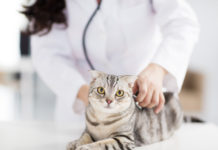Dear Elizabeth: Is it really possible that my cat has acne? Crumbcake is a handsome, slightly chubby, brown tabby cat who we adopted from the SPCA five years ago. He has always been quite healthy; we take him to our veterinarian every year for his check-up, and we havent had any worries about him. Imagine our shock when at this years examination, our veterinarian diagnosed “chin acne” on our cat! Crumbcakes chin is a little swollen, a little red, and he has a number of what look like blackheads along the edge of his lower lips. Our veterinarian recommended changing the bowl that we feed Crumby in, and asked us to buy some acne cream from the drug store. We turn to you for more information, Elizabeth: Is acne truly a feline condition? How did Crumby get it? Should we really go to the acne cream aisle in our pharmacy for his treatment, or is there a specific feline medication? Yes, cats do get acne, defined by veterinary dermatologists as a “disorder of follicular keratinization.” Feline chin acne is diagnosed in cats of every breed, age and sex although it seems most common in adult males like your boy, Crumbcake. Whether you are a cat or a lesser species (such as a human!), your skin has hair follicles with associated oil glands. Sebum (the fancy name for skin oil) is meant to travel up along the hair shaft and exit onto the surface of the skin. Acne lesions (whiteheads, blackheads and pimples) occur when hair follicles get plugged with excess oily material and dead skin cells. The plugged hair follicle may bulge and form a whitehead; the plug of sebum and skin cells may open to the surface of the skin and darken to form a blackhead (as you have seen on Crumbys chin); or the hair follicle may become inflamed or infected with bacteria, causing a pimple. Despite its characteristic appearance, my “research assistants” here at the FHC stress that other dermatitis conditions can look very similar. Many veterinarians will perform a few baseline tests to characterize a case of suspected chin acne and rule out other differentials such as demodex mites, dermatophytosis (ringworm), eosinophilic granuloma and bacterial or yeast infection. Minimum work-up will often include skin scrapings for Demodex mites, a fungal culture for ring worm, and cytology to look for bacteria and malassezia yeast. Occasionally, additional tests such as bacterial culture and biopsy are called for, especially if a case of suspected chin acne has an uncharacteristic appearance or if response to therapy is inadequate. The Causes of Feline Acne. If the baseline tests weve talked about fail to reveal other similar-appearing skin conditions a cat is left with a diagnosis of primary feline chin acne. Why an individual cat develops primary chin acne can be difficult to figure out! Veterinarians believe that some cats develop acne due to poor grooming habits and exposure to bacteria from their food and water bowls. Other cats may have increased sebaceous gland activity due to stress, metabolic disease such as diabetes and hyperthyroidism or to genetic predisposition. In many cases of primary chin acne, its just not clear why a cat has developed the dermatitis. Therapy for Crumbcakes chin acne should include targeted therapy for any underlying problems that are discovered. In addition, treatment should be aimed at the plugged, inflamed hair follicles and blackheads on his chin. First, the hairs surrounding the lesions should be clipped to make topical treatment easier, and warm water compresses applied for comfort and cleansing. After this general chin preparation, a specific treatment protocol for Crumbys chin acne will be based on your veterinarians assessment of his symptoms, and on his or her experience and opinions about what treatment is most effective. Are Human Acne Products Safe? Options for topical therapy are vast and include several products from the human arena and a few developed specifically for use in veterinary medicine. Regardless of the specific products chosen, a veterinarians goal is to help dislodge the plugs of sebum and dead cells from hair follicles, decrease sebaceous gland activity, reduce pain and inflammation and treat any infection. I hope that this overview of feline chin acne has been useful. My advice is to follow your veterinarians directions on caring for Crumbcake, and be sure to ask if you have questions about his condition or response to treatment. Love, Elizabeth



